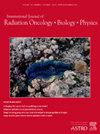前列腺先进放射技术生活质量调查 (PARTIQoL):质子疗法与 IMRT 治疗局部前列腺癌的 III 期随机临床试验
IF 6.4
1区 医学
Q1 ONCOLOGY
International Journal of Radiation Oncology Biology Physics
Pub Date : 2024-10-01
DOI:10.1016/j.ijrobp.2024.08.012
引用次数: 0
摘要
目的/目标:局部前列腺癌患者有多种治疗选择,包括使用光子或质子的体外放射治疗。质子束疗法(PBT)具有一定的剂量学优势,有可能降低治疗相关的发病率并改善肿瘤预后,但它通常比调强放射疗法(IMRT)需要更多的资源。材料/方法将中危或低危前列腺癌患者随机分配到 PBT 或 IMRT,不使用激素治疗,并根据机构、年龄、直肠间隔器使用情况和分次(79.2 Gy/44 分次 vs 70 Gy/28 分次)进行分层。在放疗结束后的60个月内,对参与者进行纵向随访,评估其肠道、泌尿和性功能方面的主要表现。次要目标包括泌尿和性功能、毒性和疗效终点的比较。结果2012年6月至2021年11月期间,来自30个招募中心的450名患者接受了随机治疗:PBT(226 例)和 IMRT(224 例),其中分别有 221 例和 216 例符合条件,并开始接受相应臂的放射治疗。在 424 名仍存活的患者中,中位随访时间为 60.3 个月。中位年龄为 68 岁(范围 46-89),59% 的患者患有中危疾病,51% 的患者接受了低分量治疗,48% 的患者使用了直肠间隔器,49% 的 PBT 患者接受了铅笔束扫描治疗。在 24 个月时,PBT 或 IMRT 在医疗保健软件肠道评分的平均变化方面没有差异(P=0.836),两组患者的评分与基线相比都仅有微小的、临床上无意义的下降(见表)。同样,较早时间点(3、6、9、12、18 个月)或较晚时间点(36、48、60 个月)的肠道功能也没有差异。其他方面(泌尿、性、激素)在任何时间点均未观察到差异。无进展生存期(PFS)无差异(60 个月时为 93.4% vs 93.7%,HR 1.16 [0.53, 2.57],P=0.706)。结论这项前瞻性随机临床试验表明,采用现代放疗治疗局部前列腺癌的患者在获得良好QOL的同时,肿瘤也得到了有效控制,PBT和IMRT之间没有明显差异。我们将继续对参与者进行长期随访和次要终点监测。本文章由计算机程序翻译,如有差异,请以英文原文为准。
Prostate Advanced Radiation Technologies Investigating Quality of Life (PARTIQoL): Phase III Randomized Clinical Trial of Proton Therapy vs. IMRT for Localized Prostate Cancer
Purpose/Objective(s)
Patients with localized prostate cancer have several treatment options including external beam radiotherapy with either photons or protons. Proton beam therapy (PBT) has certain dosimetric advantages with the potential to reduce treatment-associated morbidity and improve oncologic outcomes, but it is generally more resource intensive than intensity modulated radiation therapy (IMRT). To address the hypothesis that PBT results in improved patient-reported outcomes (PROs), PARTIQoL (NCT01617161) was conducted as a multi-center phase 3 randomized trial comparing the two modalities.
Materials/Methods
Patients with intermediate- or low-risk prostate cancer were randomized to PBT or IMRT, without hormonal therapy, stratified for institution, age, rectal spacer use, and fractionation (79.2 Gy/44 fractions vs 70 Gy/28 fractions). Participants were followed longitudinally to assess PROs of bowel, urinary, and sexual function for 60 months (mo) after completion of radiotherapy. Primary endpoint was to compare change from baseline in bowel quality of life (QOL) using the health care software score (range 0-100) at 24 mo. Secondary objectives include comparison of urinary and sexual functions, toxicity, and efficacy endpoints.
Results
Between 06/2012-11/2021, 450 patients from 30 recruiting centers were randomized: PBT (N=226) and IMRT (N=224), of whom 221 and 216 were eligible and started radiation on the respective arms. Median follow-up was 60.3 mo among 424 patients still alive. Median age was 68 yrs (range 46-89), 59% had intermediate-risk disease, 51% received hypofractionation, 48% used a rectal spacer, and 49% of PBT patients were treated with pencil beam scanning. There was no difference between PBT or IMRT in mean change of health care software bowel score at 24 mo (p=0.836), with both arms showing only small, clinically non-meaningful decline from baseline (see Table). Similarly, there was no difference in bowel function at earlier timepoints (3, 6, 9, 12, 18 mo) or later timepoints (36, 48, 60 mo). No differences were observed in other domains (urinary, sexual, hormonal) at any timepoint. There was no difference in progression-free survival (PFS) (93.4% vs 93.7% at 60 mo, HR 1.16 [0.53, 2.57], p=0.706). There was no sustained difference in any QOL domain or PFS between arms in subgroups defined by stratification variables.
Conclusion
This prospective randomized clinical trial shows that patients treated with contemporary radiotherapy for localized prostate cancer achieve excellent QOL with highly effective tumor control, without measurable differences between PBT and IMRT. We continue to monitor participants for longer follow-up and secondary endpoints.
求助全文
通过发布文献求助,成功后即可免费获取论文全文。
去求助
来源期刊
CiteScore
11.00
自引率
7.10%
发文量
2538
审稿时长
6.6 weeks
期刊介绍:
International Journal of Radiation Oncology • Biology • Physics (IJROBP), known in the field as the Red Journal, publishes original laboratory and clinical investigations related to radiation oncology, radiation biology, medical physics, and both education and health policy as it relates to the field.
This journal has a particular interest in original contributions of the following types: prospective clinical trials, outcomes research, and large database interrogation. In addition, it seeks reports of high-impact innovations in single or combined modality treatment, tumor sensitization, normal tissue protection (including both precision avoidance and pharmacologic means), brachytherapy, particle irradiation, and cancer imaging. Technical advances related to dosimetry and conformal radiation treatment planning are of interest, as are basic science studies investigating tumor physiology and the molecular biology underlying cancer and normal tissue radiation response.

 求助内容:
求助内容: 应助结果提醒方式:
应助结果提醒方式:


